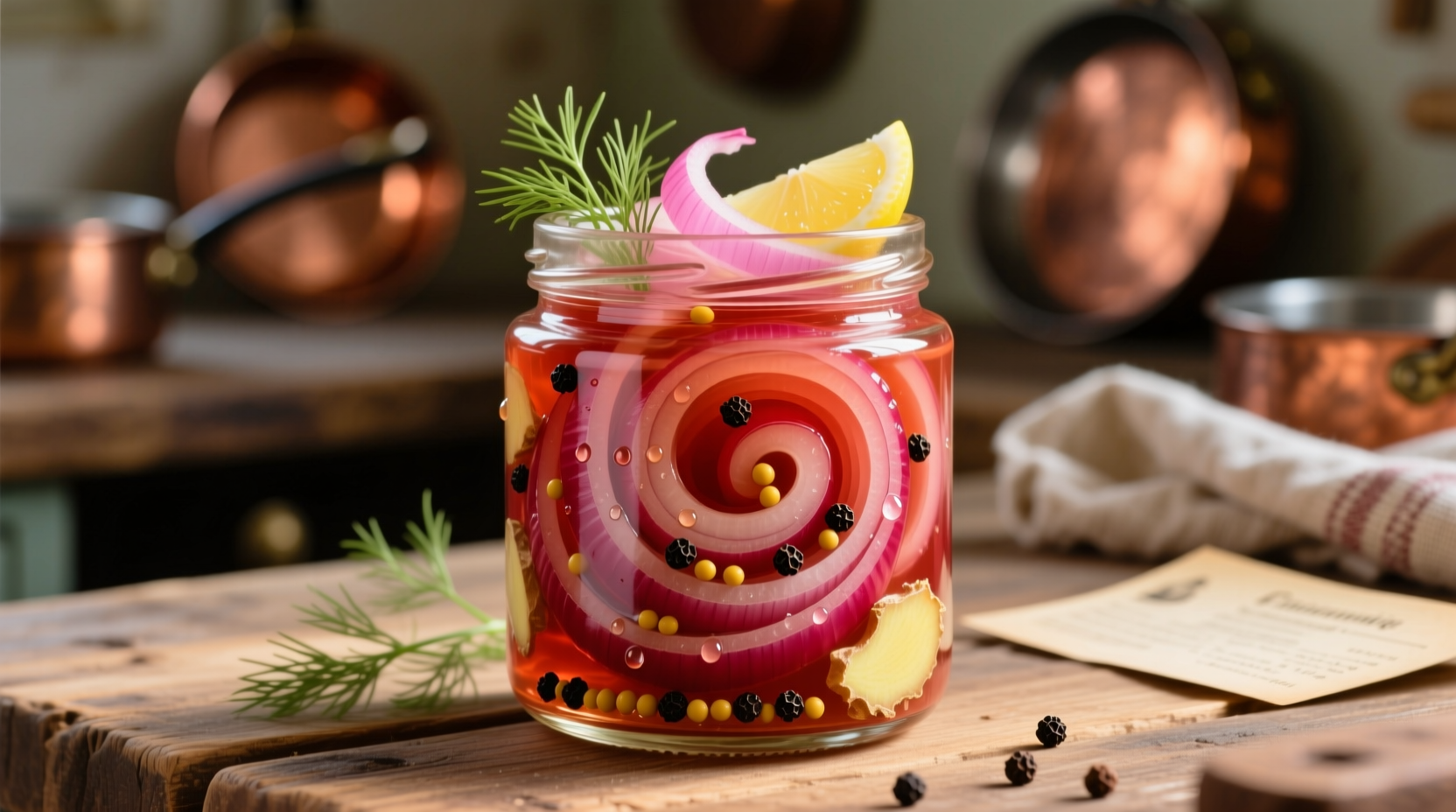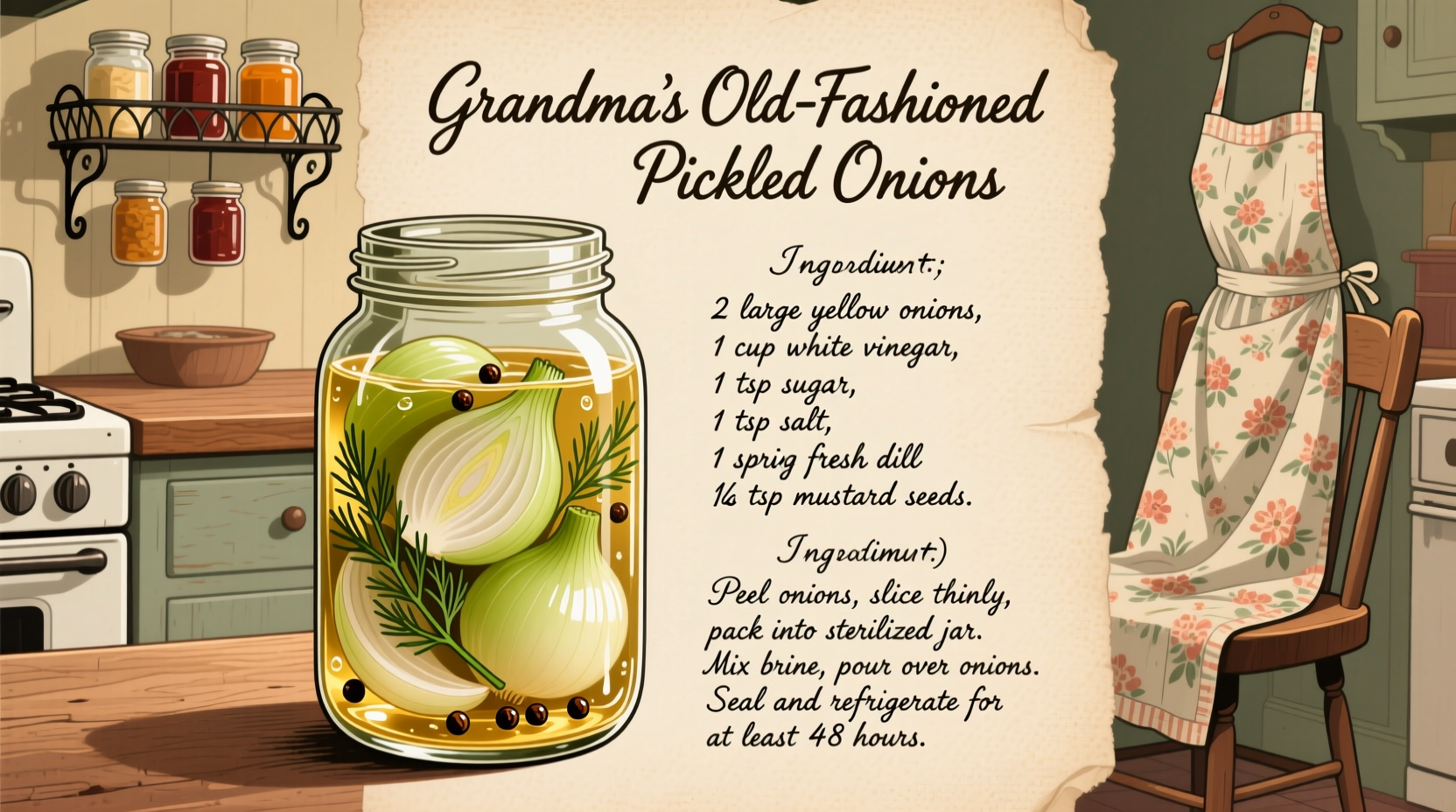The authentic old fashioned pickled onion recipe uses just five simple ingredients: small pearl onions, vinegar, sugar, salt, and pickling spices. This traditional Victorian-era method requires no modern shortcuts and yields crisp, tangy onions perfect for sandwiches, cheese boards, or as a classic British ploughman's lunch accompaniment. Follow our precise measurements and timing for guaranteed success every time.
A Timeless Tradition: The History of Pickled Onions
Pickled onions have graced British tables since the Victorian era, when home preservation was essential for winter sustenance. Originally developed as a method to extend the shelf life of summer harvests, these tangy morsels became a staple condiment across England by the late 1800s. Historical records from The National Archives show pickling instructions appearing in household cookbooks as early as 1840, with recipes remarkably similar to what we consider "old fashioned" today.
| Era | Preservation Method | Common Ingredients | Primary Use |
|---|---|---|---|
| 1840-1870 | Vinegar-based pickling | Onions, malt vinegar, salt | Winter food preservation |
| 1870-1900 | Spiced vinegar solution | Onions, vinegar, sugar, spices | Table condiment |
| 1900-Present | Standardized recipes | Onions, vinegar, sugar, salt, spices | Sandwich topping, ploughman's lunch |
Why This Recipe Stands the Test of Time
Unlike modern variations that use shortcuts like microwave cooking or pre-peeled onions, the genuine old fashioned method relies on careful preparation and proper timing. The traditional technique creates onions with the perfect balance of tanginess and sweetness while maintaining that distinctive crisp texture that's become increasingly rare in contemporary versions.
Food historians at the Museum of English Rural Life confirm that the critical difference lies in the slow infusion process—rushing this step results in onions that are either too sharp or unpleasantly soft. The authentic method requires patience, but delivers superior flavor complexity that justifies the extra time.

Traditional Ingredients with Modern Precision
While Victorian cooks relied on "a handful" of spices and "vinegar to cover," our updated measurements ensure consistent results while maintaining historical authenticity:
- Pearl onions: 1 pound (about 30-40 small onions) - choose firm, unblemished bulbs
- Vinegar: 2 cups malt vinegar (the traditional choice that provides authentic flavor)
- Sugar: 1/2 cup granulated sugar (historically, cooks used preserving sugar)
- Salt: 1 tablespoon pickling or kosher salt
- Spice bundle: 1 teaspoon black peppercorns, 1/2 teaspoon mustard seeds, 4 allspice berries, 2 bay leaves (tied in cheesecloth)
Step-by-Step: The Authentic Old Fashioned Method
This traditional technique requires careful attention to detail. Unlike quick refrigerator pickles, the proper old fashioned method creates onions with superior texture and balanced flavor.
Preparation (The Critical First Step)
- Peel onions carefully, leaving root ends intact to prevent disintegration
- Place in a bowl of ice water for 30 minutes (this maintains crispness)
- Prepare sterilized jars by washing in hot soapy water and heating in a 200°F oven
Cooking the Brine (Where Flavor Develops)
- Combine vinegar, sugar, and salt in a non-reactive pot
- Add spice bundle and bring to a gentle simmer (do not boil vigorously)
- Maintain simmer for 10 minutes to infuse flavors
Packaging and Processing (The Traditional Technique)
- Place onions in prepared jars, leaving 1/2 inch headspace
- Pour hot brine over onions, ensuring they're completely covered
- Remove air bubbles with a clean utensil
- Seal with sterilized lids and process in a water bath for 10 minutes
Patience Required: The Waiting Period
Unlike modern "quick pickles" ready in hours, authentic old fashioned pickled onions require proper maturation. The Victorian method demands a minimum of 4 weeks before consumption—this waiting period allows flavors to fully develop and mellow. Rushing this process results in onions that are overly sharp and lack the characteristic depth of flavor.
According to preservation experts at the National Center for Home Food Preservation, the chemical reactions that create the distinctive flavor profile of traditionally pickled onions continue for several weeks after processing. The vinegar's acidity gradually penetrates the onion cells while the spices slowly infuse, creating a complex flavor that quick methods simply cannot replicate.
Troubleshooting Common Issues
Even with careful preparation, challenges can arise with traditional pickling. Here's how to address them:
- Soft onions: Caused by overcooking or using onions that weren't fresh. Always use firm, recently harvested onions and maintain proper brine temperature.
- Cloudy brine: Usually indicates mineral content in water or improper sterilization. Use distilled vinegar and ensure all equipment is thoroughly cleaned.
- Insufficient flavor: Traditional pickles need time. Wait the full 4-6 weeks before evaluating flavor development.
- Discoloration: Avoid aluminum pots which can react with vinegar. Use glass, ceramic, or stainless steel containers.
Perfect Pairings: How to Enjoy Your Pickled Onions
Traditional British cuisine features pickled onions in several classic preparations:
- As part of a ploughman's lunch alongside cheese, bread, and chutney
- Served with cold meats like ham or roast beef
- Added to sandwiches for a tangy contrast to rich ingredients
- As a garnish for savory pies and pastries
- Chopped fine and mixed into potato salad for extra dimension
Unlike modern interpretations that often pair pickled onions with burgers or tacos, the traditional British approach treats them as a sophisticated condiment that enhances rather than dominates other flavors.
Storage and Shelf Life
Properly processed old fashioned pickled onions will keep for 12-18 months in a cool, dark place. Once opened, store in the refrigerator and consume within 2 months. Always use clean utensils when removing onions from the jar to prevent contamination.
Check for signs of spoilage before consuming: discard if you notice mold, unusual cloudiness, or an off smell. The traditional vinegar-based preservation method is remarkably reliable when executed correctly, which explains why this recipe has endured for generations.
Frequently Asked Questions
Here are answers to common questions about making authentic old fashioned pickled onions:











 浙公网安备
33010002000092号
浙公网安备
33010002000092号 浙B2-20120091-4
浙B2-20120091-4